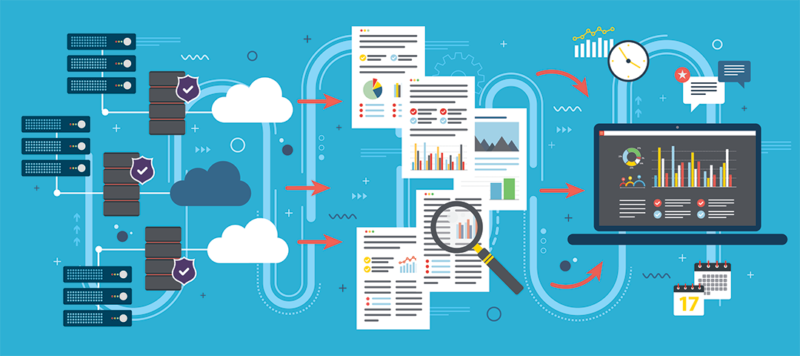Manually tracking assets for any company can be a logistical nightmare. When it comes to large enterprise organizations, it’s nearly impossible. Fortunately, enterprise asset management software exists. This software is an invaluable tool that not only tracks inventory across multiple locations, but also helps companies with asset maintenance, regulatory compliance, and more.
In this post, we’ll cover everything you need to know about choosing an enterprise asset management tool, including:
- What is enterprise asset management software?
- Who uses EAM software?
- What are the top benefits of EAM software?
- Cloud-based vs. on-prem EAM solutions: Pros and Cons
- Best practices for choosing EAM software
What is enterprise asset management software?
Enterprise asset management software, also known as EAM, makes it easy for a company to track and manage all of their operational assets, like physical assets and software (including keeping tabs on asset lifecycle costs). This means you have full asset lifecycle management from design or procurement through to maintenance operations and disposal.
The software is also helpful for inventory management, asset management tasks, regulatory compliance, as well as financial management (think asset utilization, financial reporting, depreciation, business intelligence, etc).
Who uses EAM software?
Traditionally, large-scale enterprises have been the primary users of enterprise management software. But fast-growing, smaller companies on the rise are now seeing the benefits of implementing this type of software early on.
Managers of small, growing companies or large-scale enterprise operations looking for transparency and accountability with asset tracking should leverage EAM software. Companies looking to control operational costs are also good candidates for the software. For example, IT managers will usually deploy EAM software to track a company’s IT equipment and involve finance so they can keep a record of asset depreciation as well as HR to keep on top of on-boarding and off-boarding.
Likewise, companies with asset-heavy operations can benefit from using the software to gain full oversight of company assets. The software can also be used as an invaluable tool for setting up employee request portals, maintenance management, as well as companies needing to focus on regulatory compliance, such as those in manufacturing or construction industries.
What are the top benefits of EAM software?
Company leaders in all industries looking to manage their assets can benefit from EAM software. Here are some of the top benefits after implementing this type of software:
- Efficient asset monitoring: EAM software delivers actionable insights in a centralized location so managers can quickly and efficiently monitor data. The software helps to bridge the gap between information silos to allow for more educated decision-making.
- For example, EAM software can provide an IT department a single pane of glass to see equipment being used by employees such as networked (i.e. laptops, printers) and non-networked equipment (i.e. monitors) and, equipment not being used such as old laptops, monitors or printers.
- Maximum utilization of assets: With EAM software, assets can be tracked throughout the entire lifecycle. This means they can be fully utilized and properly disposed of, replaced, or sold when they no longer make financial sense for the company to maintain. EAM software can help tell you when this may occur with current, deployed equipment and how much has already been sold or retired.
- Improved maintenance management: Tracking all of your assets across the enterprise means you’ll have a firm grasp of maintenance schedules and needs. Maintenance is typically more cost-effective than fixing something that’s broken. Using EAM software to monitor maintenance schedules can save the company a lot of money in the long run.
- For example, there’s many companies who need to ensure certain equipment is calibrated every year or six months and it’s vital that those calibrations are never missed, and if they are, the equipment must not be used.
- Simplified regulatory compliance: Abiding by industry regulations and policies is much easier if you can track your assets. For example, being able to pull up maintenance records or track machine parts to comply with recall repairs.

Cloud-based vs. on-prem EAM solutions: Pros and Cons
You essentially have two options when it comes to implementing asset management tools for your organizations: cloud-based software, like Reftab, or an on-premise solution. With cloud-based, your data is hosted on the vendor’s server, and you access the software via the internet. With on-premise, the software is installed locally on your company’s computers and servers.
Here are the pros and cons of each option:
Cloud-based pros
Easy / no hassle setup
Cloud-based solutions require no work to get started. The software is accessible via a browser. All you and your team need to do is create an account, login and import your data. You’ve got a working solution up and running very quickly.
Cost-effective
Cloud-based solutions are typically more affordable. You don’t have to have someone create a custom solution and install it onsite. Monthly subscription or plan fees may add up, but you still don’t have upfront costs with cloud-based software or ongoing maintenance. You also have reduced energy costs without the need to run physical servers on location.
Support
Upgrades and updates are handled by the software provider, not your in-house team.
Scalability
It’s quick to get started with cloud-based software and even faster to scale. As your business grows, you can simply choose a new plan with more storage or advanced features. You can even reduce your plan features if you find the current plan you’re on is more robust than necessary.
Cloud-based cons
Connectivity
If you’re having internet issues, then your entire system could go down. You’ll need a reliable internet connection to access your cloud data at all times. With an on-premise solution, you can still access your data if you’re still physically at the office and you loose connection to the internet.
Less customizable
While you can certainly pick from features and plan tiers with cloud-based software, cloud-based options are still less customizable. The software isn’t designed specifically for your business needs, so you’ll need to find the pre-made software that aligns most closely with your asset tracking goals.
On-premise pros
Lifetime cost
Upfront and maintenance costs are often higher for on-premise solutions, but depending on the length of time the solution is utilized you may end up paying less in the long run for on-premise vs. cloud-based. This is because you’re typically paying once for the license and installation, whereas cloud-based is an ongoing monthly or annual fee.
Flexibility
An on-premise solution gives you complete control of your asset management data. This is because you own the software or hardware. You can set up the system however you want.
On-premise cons
Maintenance
Ongoing maintenance is typically included as part of a cloud-based plan. With on-prem, you’re the one responsible for when and how maintenance will occur. This includes backup, storage, and disaster recovery when applicable. Costs can quickly add up.
Implementation
It simply takes longer to get started with on-premise solutions because they have to be manually installed first. The solution must be installed on servers, computers, and other individual devices before you can get started.
Best practices for choosing EAM software
For most companies, a cloud-based EAM software solution is a better option than on-prem solutions. But selecting the right EAM software for your business requires a bit of research and knowing your criteria beforehand. We’ve made the process easier for you by rounding up 6 of the best practices to keep in mind when shopping for EAM software.
Set a budget
Before you go searching for EAM software, you’ll need to set a monthly or annual budget for the software.
Keep in mind some providers charge a flat rate while others charge per user or location. Pay close attention to add-ons or caveats that affect the pricing.
Look for compatibility
The best EAM software is the one you’ll use. If the software isn’t compatible with your existing systems, software, or solutions, then you’ll struggle to implement it in your business. Look for software that can be integrated with your current tools.
Make a list of your must-have features
What features are a must-have, and which ones would never be used? Do your research to determine which features you need from the software. You don’t want to be without the functions you need, but you also don’t want to overpay for robust software features that you’ll never use.
Read customer reviews
Look for reviews of the software before you commit on review sites, like Capterra, G2, and TrustPilot, as well as social media reviews. If possible, look for reviews from users in your same industry. This will give you a good sense of how the software could be used for your company.
***
Remember, the software you choose should be a good fit for your business. Not everyone has the same asset tracking needs or goals.
On the market for asset management software? Schedule a free demo of Reftab here: Reftab Calendar
